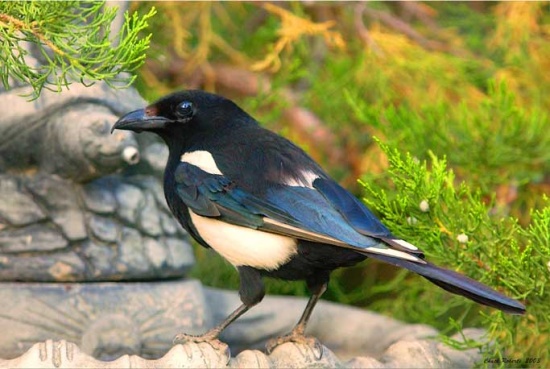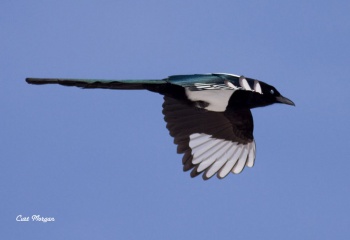
- Pica hudsonia
Identification:
Length 45-60 cm (17¾-23½ in); weight 176-216 g (male), 135-173 g (female)
A large, dramatically contrasted black and white bird with iridescent feathers, including green and purple, typical of the family Corvidae.
One of four passerines with tails longer than their bodies in North America; the others are Yellow-billed Magpie, Scissor-tailed Flycatcher, and Fork-tailed Flycatcher.
Similar Species
Similar to the Yellow-billed Magpie (P. nuttalli), but with black bill and eye ring; the former is to be found only in central California, whereas P. hudsonia has a far greater range, and is larger. It is the magpie found in the rest of the west and mid-west.
Distribution:
Western North America: southern Alaska, and from eastern British Columbia, eastward to western Ontario, southward through the western and midwestern United States to northern Arizona. In central California it is replaced by the Yellow-billed Magpie.
Locally common.
Taxonomy
This monotypic[1] species was formerly considered conspecific with Eurasian Magpie Pica pica, but was found to be more closely related to Yellow-billed Magpie than to the Old World birds.
Habitat
Open country with brush and groves of trees; common in Great Basin high sage desert and the plains states, especially in riparian areas.
Behaviour
Usually seen in small groups, with much interaction.
Diet
Perches in trees or bushes, dropping to the ground to forage for insects and larvae. A carrion scavenger; probably most often seen as it picks at roadkill in small groups.
Breeding
Builds large, intricate dome-shaped structures of mud and sticks for nesting.
References
- Clements, J. F., T. S. Schulenberg, M. J. Iliff, D. Roberson, T. A. Fredericks, B. L. Sullivan, and C. L. Wood. 2015. The eBird/Clements checklist of birds of the world: v2015, with updates to August 2015. Downloaded from http://www.birds.cornell.edu/clementschecklist/download/
- Handbook of the Birds of the World Alive (retrieved June 2016)
Recommended Citation
- BirdForum Opus contributors. (2025) Black-billed Magpie. In: BirdForum, the forum for wild birds and birding. Retrieved 11 May 2025 from https://www.birdforum.net/opus/Black-billed_Magpie
External Links
GSearch checked for 2020 platform.1




